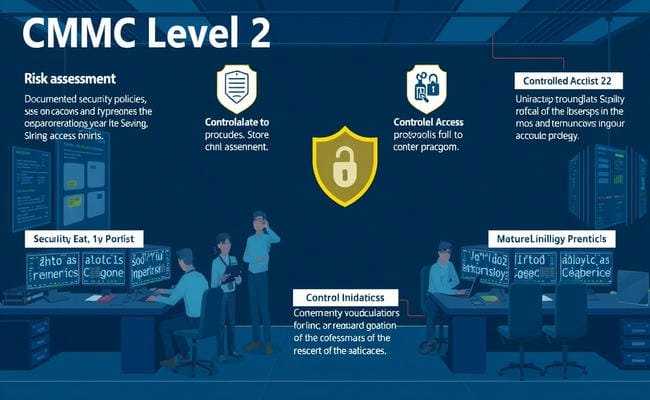
How To Use A Sengo In Noteflight
January 23, 2025A strong security posture isn’t just about having firewalls and antivirus software—it’s about staying ahead of evolving threats. Organizations handling sensitive data must step up their defenses to meet CMMC level 2 requirements, ensuring that their networks, endpoints, and privileged access are tightly controlled. Without the right safeguards, businesses risk exposure to cyber threats that can compromise valuable information.
Network Segmentation Strategies That Prevent Unauthorized Lateral Movement
Keeping unauthorized users from moving freely within a network is a critical part of meeting CMMC compliance requirements. Many businesses overlook the importance of proper segmentation, assuming firewalls and traditional security tools are enough. However, once an intruder gains access, an unsegmented network allows them to move laterally, reaching sensitive data without resistance. Effective segmentation strategies ensure that even if one part of a network is compromised, the breach stops there.
Network segmentation isn’t just about breaking a system into sections—it requires strategic access control and monitoring. Dividing a network into smaller, controlled zones limits an attacker’s ability to explore deeper into a system. For businesses working toward CMMC level 2 requirements, segmentation must be enforced with strict access policies, micro-segmentation techniques, and continuous monitoring.
Endpoint Detection and Response Capabilities That Identify Advanced Threats
Traditional antivirus software is no longer enough to keep pace with today’s cyber threats. Advanced attacks often bypass basic defenses, lurking undetected in an organization’s network. Endpoint Detection and Response (EDR) solutions provide real-time monitoring, detecting and mitigating threats before they escalate. Without a strong EDR system in place, businesses struggle to meet CMMC level 2 requirements and remain vulnerable to sophisticated cyber threats.
EDR solutions analyze endpoint behavior, flagging anomalies that indicate a potential attack. Whether it’s unusual login activity, unauthorized file access, or suspicious processes running in the background, EDR tools provide visibility into actions that traditional security tools miss. Organizations pursuing CMMC compliance requirements should implement EDR with AI-driven threat intelligence, ensuring that no malicious activity goes unnoticed.
Privileged Access Management Controls That Limit High-risk User Permissions
Not every employee needs full access to critical systems. Without strict control over privileged accounts, businesses increase the risk of insider threats and credential-based attacks. Privileged Access Management (PAM) ensures that only authorized users can access high-risk data and systems, preventing unnecessary exposure. Organizations aiming for CMMC level 2 requirements must implement PAM to reduce vulnerabilities and limit damage in case of a breach.
A strong PAM strategy includes role-based access control, multi-factor authentication, and continuous monitoring of privileged accounts. Stolen or misused credentials are among the leading causes of security breaches, making it essential to restrict admin-level access to only those who absolutely need it. By implementing just-in-time access and automated privilege escalation processes, businesses minimize security gaps that attackers often exploit.
Encryption Standards That Protect Data at Rest, in Transit, and During Processing
Encryption isn’t just a checkbox for compliance—it’s a necessity for securing sensitive information from unauthorized access. Without strong encryption protocols, data remains vulnerable to theft, interception, and manipulation. CMMC level 2 requirements emphasize the need for encryption that protects data at all stages, ensuring that even if information is stolen, it remains unreadable to unauthorized users.
Data encryption applies to storage, transmission, and real-time processing. Protecting data at rest involves encrypting stored files, databases, and backups, preventing attackers from accessing raw information. Encrypting data in transit ensures that files, emails, and other communications remain protected as they move across networks. Encryption during processing safeguards information as it is being used, ensuring that no unauthorized processes can extract sensitive content. By implementing end-to-end encryption with strong cryptographic standards, businesses meet CMMC compliance requirements while reinforcing their security posture.
Automated Patch Management for Addressing Software and Firmware Vulnerabilities
Outdated software is one of the easiest targets for cybercriminals. Every unpatched vulnerability creates an open door for attacks, yet many organizations struggle to keep up with software updates manually. Automated patch management helps businesses meet CMMC level 2 requirements by ensuring that security updates are applied without delay, reducing the risk of exploitation.
Automated tools continuously scan for vulnerabilities, prioritize critical patches, and deploy updates across all systems without disrupting operations. This proactive approach eliminates the lag time that attackers rely on to exploit weaknesses. Businesses that fail to implement automated patching risk falling behind on security updates, making them easy targets for malware, ransomware, and zero-day attacks. By automating the patching process, organizations improve compliance with CMMC requirements and strengthen their defenses against emerging threats.
Audit-ready Documentation That Demonstrates Compliance with CMMC Level 2 Controls
Security isn’t just about implementing the right controls—it’s about proving that those controls are working. Many organizations struggle with the documentation process, making it difficult to demonstrate compliance when required. CMMC level 2 requirements demand detailed, audit-ready records that outline security policies, procedures, and control implementations. Without proper documentation, businesses risk failing assessments even if they have strong security measures in place.
Keeping accurate records involves logging security events, tracking access controls, and maintaining reports that detail security incidents and remediation efforts. Documentation should be structured, easy to access, and regularly updated to reflect changes in security posture. Organizations must prepare for audits by ensuring that every security measure is backed by clear evidence of implementation. Well-organized documentation not only streamlines compliance but also enhances overall security transparency, making it easier to identify and address potential weaknesses.




